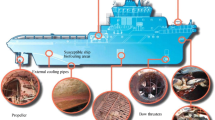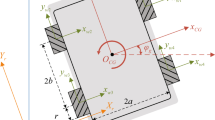Abstract
In this paper we propose a data-driven motion control approach for a biomimetic robotic fish. The task of the motion control is to achieve desired motion by means of controlling the fish-like swimming gaits of the robot. Due to the complexity of hydrodynamics, it is impossible to derive an analytic model that can precisely describe the interaction between the robotic fish and surrounding water during motion. To address the lack of the robotic model, we explore data-based modeling and control design methods. First, through biomimetic learning from real fish motion data, a General Internal Model (GIM) is established. GIM translates fish undulatory body motion into robotic joint movement; associates the fish gait patterns, such as cruise and turning, with corresponding joint coordination; and adjusts the robotic velocity by GIM parameters. Second, by collecting robotic motion data at a set of operating points, we obtain the quantitative mapping from GIM tuning parameters to robotic speed. Third, applying the quantitative mapping and using GIM parameters as manipulating variables, a feedforward control is computed according to the desired speed, which greatly expedites the initial movement of the robotic fish. Fourth, Proportional- Integral-Derivative (PID) is employed as feedback control, together with an inverse mapping that compensates for the nonlinearity appeared in the quantitative mapping. Fifth, modified Iterative Feedback Tuning (IFT) is developed as an appropriate data-driven tuning approach to determine controller gains. By switching between feedforward and feedback, the motion performance is improved. Finally, real-time control of robotic fish is implemented on a two-joint platform, and two representative swimming gaits, namely “cruise” and “cruise in turning”, are achieved.
Similar content being viewed by others
References
Barrett D S. Propulsive efficiency of a flexible hull underwater vehicle, Ph.D. thesis, Massachusetts Institute of Technology, 1996.
Lighthill M J. Note on the swimming of slender fish. Journal of Fluid Mechanics, 1960, 9, 305–317.
Lighthill M J. Large-amplitude elongated-body theory of fish locomotion. Proceedings of the Royal Society of London, Series B, 1971, 179, 125–138.
Anderson I A, Kelch M, Sun S, Jowers C, Xu D, Murray M M. Artificial muscle actuators for a robotic fish. Biomimetic and Biohybrid Systems, 2013, 8064, 350–352.
Wang Z, Hang G, Li J, Wang Y, Xiao K. A micro-robot fish with embedded SMA wire actuated flexible biomimetic fin. Sensors and Actuators A: Physical, 2008, 144, 354–360.
Colgate J, Lynch K M. Mechanics and control of swimming: A review. IEEE Journal of Oceanic Engineering, 2004, 29, 660–673.
Kato N. Control performance in the horizontal plane of a fish robot with mechanical pectoral fins. IEEE Journal of Oceanic Engineering, 2000, 25, 121–129.
Liu J, Hu H. Biological inspiration: From carangiform fish to multi-joint robotic fish. Journal of Bionic Engineering, 2010, 7, 35–48.
Ijspeert A J. Central pattern generators for locomotion control in animals and robots: A review. Neural Networks, 2008, 21, 642–653.
Hu Y, Tian W, Liang J, Wang T. Learning fish-like swimming with a CPG-based locomotion controller. IEEE/RSJ International Conference on Intelligent Robots and Systems, 2011, 1863–1868.
Niu X, Xu J, Ren Q. Locomotion learning for an anguilliform robotic fish using central pattern generator approach. IEEE Transaction on Industrial Electronics, 2014, 61, 4780–4787.
Zhao W, Hu Y, Wang L. Design and CPG-based control of biomimetic robotic fish. IET control theory and application, 2009, 3, 281–293.
Ren Q, Xu J, Gao W, Niu X. Generation of robotic fish locomotion through biomimetic learning. IEEE/RSJ International Conference on Intelligent Robots and Systems, 2012, 815–821.
Ren Q, Xu J, Niu X. A gim-based biomimetic learning approach for motion generation of a multi-joint robotic fish. Journal of Bionic Engineering, 2013, 10, 421–433.
McIsaac K A, Ostrowski J P. Motion planning for anguilliform locomotion. IEEE Transtraction on Robotics and Automation, 2003, 19, 637–652.
Saimek S, Li P Y. Motion planning and control of a swimming machine. American Control Conference, 2001, 1, 125–130.
Wen L, Wang T, Wu G, Liang J, Wang C. Novel method for the modeling and control investigation of efficient swimming for robotic fish. IEEE Transtraction on Industrial Electronics, 2012, 59, 3176–3188.
Harper K A, Berkemeier M D, Grace S. Modeling the dynamics of spring driven oscillating-foil propulsion. IEEE Journal of Oceanic Engineering, 2002, 23, 285–296.
Hjalmarsson H, Gevers M, Gunnarsson S, Lequin O. Iterative feedback tuning: Theory and applications. IEEE Control System, 1998, 18, 26–41.
Blake R W. Fish Locomotion, Cambridge University Press, Cambridge, 1983.
Seo K, Chung S J, Slotine E. CPG-based control of a turtle- like underwater vehicle. Autonomous Robots, 2010, 28, 247–269.
Hjalmarsson H, Gunnarsson S, Gevers M. A convergent iterative restricted complexity control design scheme. Proceedings of the 33rd IEEE Conference on Decision and Control, 1994, 1, 1735–1740.
Hjalmarsson H. Iterative feedback tuning an overview. International Journal of Adaptive Control and Signal Processing, 2002, 16, 373–395.
Huusom J K, Poulsen N K, Jrgensen S B. Improving convergence of iterative feedback tuning. Journal of Process Control, 2009, 19, 570–578.
Author information
Authors and Affiliations
Corresponding author
Rights and permissions
About this article
Cite this article
Ren, Q., Xu, J. & Li, X. A data-driven motion control approach for a robotic fish. J Bionic Eng 12, 382–394 (2015). https://doi.org/10.1016/S1672-6529(14)60130-X
Published:
Issue Date:
DOI: https://doi.org/10.1016/S1672-6529(14)60130-X




